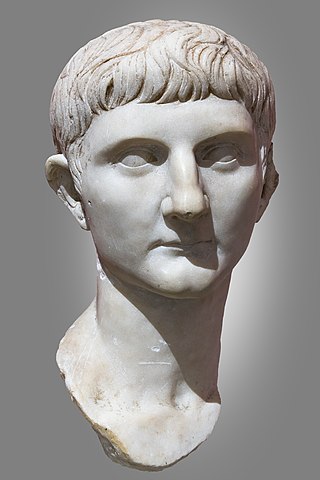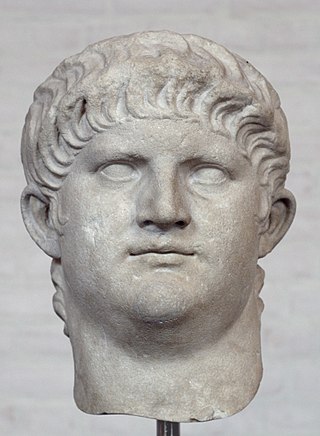
Gaius Caesar Augustus Germanicus, better known by his nickname Caligula, was Roman emperor from AD 37 until his assassination in AD 41. He was the son of the Roman general Germanicus and Agrippina the Elder, Augustus' granddaughter, members of the first ruling family of the Roman Empire. He was born two years before Tiberius was made emperor. Gaius accompanied his father, mother and siblings on campaign in Germania, at little more than four or five years old. He had been named after Gaius Julius Caesar, but his father's soldiers affectionately nicknamed him "Caligula".

Gnaeus Julius Agricola was a Roman general and politician responsible for much of the Roman conquest of Britain. Born to a political family of senatorial rank, Agricola began his military career as a military tribune under Governor Gaius Suetonius Paulinus. In his subsequent career, he served in a variety of political positions in Rome. In 64, he was appointed quaestor in Asia province. Two years later, he was appointed Plebeian Tribune, and in 68, he was made praetor. During the Year of the Four Emperors in 69, he supported Vespasian, general of the Syrian army, in his bid for the throne.

Germanicus Julius Caesar was an ancient Roman general and politician most famously known for his campaigns in Germania. The son of Nero Claudius Drusus and Antonia the Younger, Germanicus was born into an influential branch of the patrician gens Claudia. The agnomen Germanicus was added to his full name in 9 BC when it was posthumously awarded to his father in honor of his victories in Germania. In AD 4 he was adopted by his paternal uncle Tiberius, himself the stepson and heir of Germanicus' great-uncle Augustus; ten years later, Tiberius succeeded Augustus as Roman emperor. As a result of his adoption, Germanicus became an official member of the gens Julia, another prominent family, to which he was related on his mother's side. His connection to the Julii Caesares was further consolidated through a marriage between him and Agrippina the Elder, a granddaughter of Augustus. He was also the father of Caligula, the maternal grandfather of Nero, and the older brother of Claudius.

Nero Claudius Caesar Augustus Germanicus was a Roman emperor and the final emperor of the Julio-Claudian dynasty, reigning from AD 54 until his death in AD 68.

The 40s decade ran from January 1, AD 40, to December 31, AD 49.

Cadbury Castle is a Bronze and Iron Age hillfort in the civil parish of South Cadbury in the English county of Somerset. It is a scheduled monument and has been associated with King Arthur's legendary court at Camelot.
Archaeology is the study of human activity in the past, primarily through the recovery and analysis of the material culture and environmental data that they have left behind, which includes artifacts, architecture, biofacts and cultural landscapes.

The Lunt Roman Fort is the archaeological site of a Roman fort, of unknown name, in the Roman province of Britannia. It is open to the public and located in the village of Baginton on the south eastern outskirts of Coventry. The fort has now been fully excavated and partially reconstructed; the wooden gateway rebuild was led by archaeologist Margaret Rylatt, using the same tools and techniques that the military engineers of the Roman Army would have used. In 2001, Anglo Saxon artefacts dating to Sub-Roman Britain were discovered on the site.

Julia Livilla was the youngest child of Germanicus and Agrippina the Elder and the youngest sister of the Emperor Caligula.

The Basilica Julia was a structure that once stood in the Roman Forum. It was a large, ornate, public building used for meetings and other official business during the Roman Empire. Its ruins have been excavated. What is left from its classical period are mostly foundations, floors, a small back corner wall with a few arches that are part of both the original building and later imperial reconstructions and a single column from its first building phase.
John Bryan Ward-Perkins, was a British Classical architectural historian and archaeologist, and director of the British School at Rome.
The Saepta Julia was a building in the Campus Martius of Rome, where citizens gathered to cast votes. The building was conceived by Julius Caesar and dedicated by Marcus Vipsanius Agrippa in 26 BCE. The building replaced an older structure, called the Ovile, built as a place for the comitia tributa to gather to cast votes. The Saepta Julia can be seen on the Forma Urbis Romae, a map of the city of Rome as it existed in the early 3rd century CE. Part of the original wall of the Saepta Julia can still be seen right next to the Pantheon.

The Velabrum is the low valley in the city of Rome that connects the Forum with the Forum Boarium, and the Capitoline Hill with the western slope of the Palatine Hill. The outer boundaries of the area are not themselves clear. Roman etymologies of the name are confused, with attempts to connect it to the Latin words vehere (conveyance) and velum (cloth): Varro, Propertius, and Tibullus claimed that it was the location of a ferry; Plutarch, however, claimed the name derived from the awnings placed over the Circus Maximus during games. The name may also translate to "place of mud".

Junia Claudilla, also known as Junia Claudia, was the first wife of the Roman Emperor Caligula before he came to power.
Elaine Fantham was a British-Canadian classicist whose expertise lay particularly in Latin literature, especially comedy, epic poetry and rhetoric, and in the social history of Roman women. Much of her work was concerned with the intersection of literature and Greek and Roman history. She spoke fluent Italian, German and French and presented lectures and conference papers around the world—including in Germany, Italy, the Netherlands, Norway, Argentina, and Australia.

The Temple of Divus Augustus was a major temple originally built to commemorate the deified first Roman emperor, Augustus. It was built between the Palatine and Capitoline Hills, behind the Basilica Julia, on the site of the house that Augustus had inhabited before he entered public life in the mid-1st century BC. It is known from Roman coinage that the temple was originally built to an Ionic hexastyle design. However, its size, physical proportions and exact site are unknown. Provincial temples of Augustus, such as the much smaller Temple of Augustus in Pula, now in Croatia, had already been constructed during his lifetime. Probably because of popular resistance to the notion, he was not officially deified in Rome until after his death, when a temple at Nola in Campania, where he died, seems to have been begun. Subsequently, temples were dedicated to him all over the Roman Empire.
William Vernon Harris was the William R. Shepherd Professor of History at Columbia University until December 2017. He is the author of numerous groundbreaking monographs on the Greco-Roman world, he is a Fellow of the American Academy of Arts & Sciences, and he was awarded the Distinguished Achievement Award by the Andrew W. Mellon Foundation in 2008.
Andrew Ian Wilson is a British classical archaeologist and Head of School of Archaeology at the University of Oxford. He was director of the Oxford Institute of Archaeology from 2009 to 2011. Wilson's main research interests are the economy of the Roman world, Greek and Roman water supply, and ancient technology.

The Domus Tiberiana was an Imperial Roman palace in ancient Rome, located on the northwest corner of the Palatine Hill. It probably takes its name from a house built by the Emperor Tiberius, who is known to have lived on the Palatine, though no sources mention his having built a residence. It was enlarged by the successors to Tiberius, and would have been the principal Roman residence of Tiberius, Caligula, Claudius, and Nero during the early part of his reign. Relatively little is known of the structure archaeologically, since the Farnese Gardens have occupied the site of the main level since the 16th century, making excavation difficult.

The Château Prince Rupert was an unexecuted hotel to be built in Prince Rupert, British Columbia. The hotel was planned by the Grand Trunk Pacific Railway and was designed by Francis Rattenbury. The architect's first sketches were made in September 1911, and he completed the final plans in June 1913. Work on the foundations began in late 1913, but halted shortly thereafter and never resumed.















